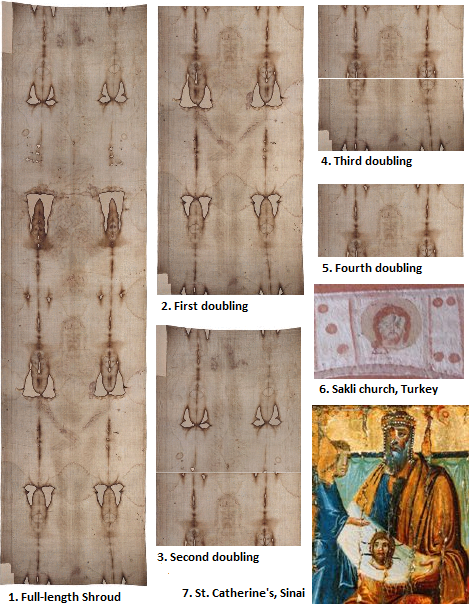As I mentioned, the Acts of Thaddeus uses the Greek word “tetradiplon” that was translated as “towel”. Towel is not the best way to translate this. Tetradiplon literally means “four double” or “four folding”. Why would it be translated towel and what is the significance of a cloth that is folded four times?
It was originally theorized by Ian Wilson this is a reference to the TS.
When Ian Wilson read the AT account he learned that what the Greek text actually said was that Jesus was given a rakos (piece of cloth) which was a tetradiplon, a word translated as “doubled in four,” and then imprinted his face on the sindon (linen). Rakos and sindon are common words, but tetradiplon very rare. Surprisingly, this word was never used except in reference to the Edessa Image. By three simple width-wide foldings, Wilson found that the Shroud of Turin was easily converted into a cloth with four, two-fold layers. Additionally, the final panel would be a landscape shaped horizontal rectangle. In this arrangement, through no special effort, this panel (one-eighth the original Shroud size) would show only the Shroud’s face, with the remaining body images hidden within the folds. Wilson noticed that the earliest surviving pictures of what the entire Icon actually looked like (from the 10th to 13th centuries) showed a rectangular picture frame with just a face on a cloth, seen through a circular opening in a slipcover. It was almost always set in a landscape (rectangular) shape, as opposed to the more artistically acceptable portrait shape (vertical rectangle) (Wilson 1979: 119 – 120). For Wilson these observations were an epiphany unlocking some of the Shroud’s earlier history, including a variety of mysterious changes in Christian art.
https://biblearchaeology.org/research/t … -to-edessa
A folded TS explains why the image of Edessa has a face of Jesus on a rectangular landscape oriented cloth.
Though Wilson proposed the cloth was folded three times, Stephen Jones gives an explanation how the TS could’ve been folded four times.

Tetradiplon and the Shroud of Turin illustrated: The full-length Shroud of Turin (1), is doubled four times (2 through 5), resulting in Jesus’ face within a rectangle, in landscape aspect (5), exactly as depicted in the earliest copies of the Image of Edessa, the 11th century Sakli church, Turkey (6) and the 10th century icon of King Abgar V of Edessa holding the Image of Edessa, St. Catherine’s monastery, Sinai (7).]
https://debatingchristianity.com/forum/viewtopic.php?p=1122301#p1122301
